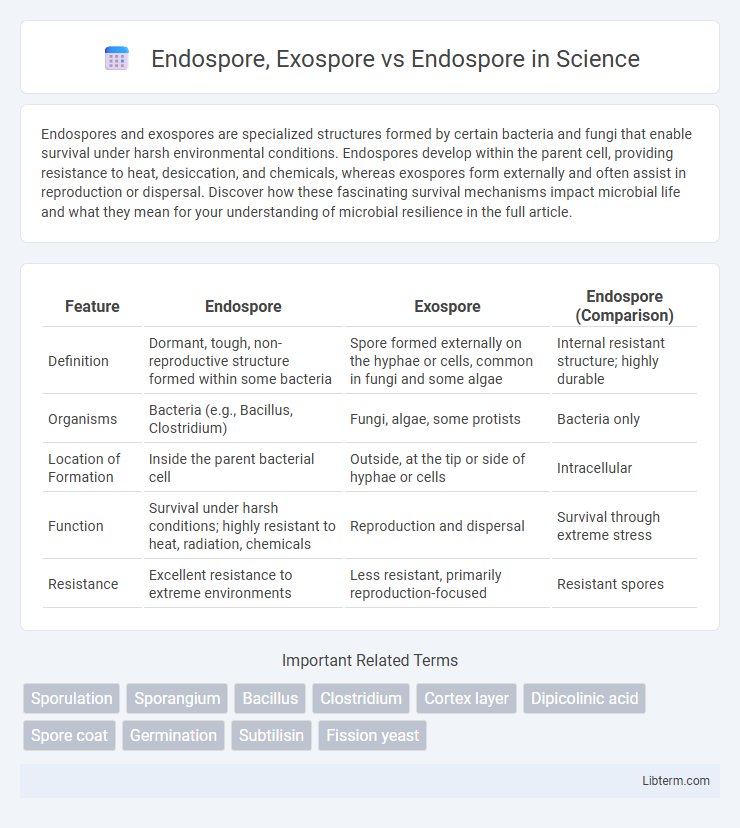Endospores and exospores are specialized structures formed by certain bacteria and fungi that enable survival under harsh environmental conditions. Endospores develop within the parent cell, providing resistance to heat, desiccation, and chemicals, whereas exospores form externally and often assist in reproduction or dispersal. Discover how these fascinating survival mechanisms impact microbial life and what they mean for your understanding of microbial resilience in the full article.
Table of Comparison
| Feature | Endospore | Exospore | Endospore (Comparison) |
|---|---|---|---|
| Definition | Dormant, tough, non-reproductive structure formed within some bacteria | Spore formed externally on the hyphae or cells, common in fungi and some algae | Internal resistant structure; highly durable |
| Organisms | Bacteria (e.g., Bacillus, Clostridium) | Fungi, algae, some protists | Bacteria only |
| Location of Formation | Inside the parent bacterial cell | Outside, at the tip or side of hyphae or cells | Intracellular |
| Function | Survival under harsh conditions; highly resistant to heat, radiation, chemicals | Reproduction and dispersal | Survival through extreme stress |
| Resistance | Excellent resistance to extreme environments | Less resistant, primarily reproduction-focused | Resistant spores |
Introduction to Spores in Microbiology
Endospores are highly resistant, dormant structures formed within certain bacterial cells, primarily in genera like Bacillus and Clostridium, enabling survival in extreme environmental conditions. Exospores, in contrast, are spores formed externally on the parent cell surface, typical of some fungi and algae, and serve as reproductive units rather than dormant survival forms. Understanding the distinctions between endospore and exospore formation is crucial in microbiology for studying microbial life cycles, resistance mechanisms, and environmental adaptability.
What is an Endospore?
An endospore is a highly resistant, dormant structure formed within certain bacteria, primarily Bacillus and Clostridium species, to survive extreme environmental conditions such as heat, radiation, desiccation, and chemicals. Unlike exospores, which are reproductive spores formed outside the parent cell, endospores develop internally and ensure bacterial survival rather than reproduction. The complex multilayered coat of an endospore protects its genetic material, enabling bacteria to remain viable for extended periods.
Endospore Structure and Composition
Endospores are highly resilient structures formed within certain bacteria, primarily composed of a core containing DNA, ribosomes, and dipicolinic acid, surrounded by a cortex of peptidoglycan and multiple protective layers including the spore coat made of proteins. The core's low water content and the presence of calcium dipicolinate contribute to endospore resistance against heat, UV radiation, and chemical damage. In contrast, exospores, which bud off the parent cell externally, lack the dense protein coat and complex multilayer structure characteristic of endospores, resulting in lower durability and resistance mechanisms.
Functions and Importance of Endospores
Endospores serve as highly resistant structures enabling bacteria to survive extreme environmental stress such as heat, desiccation, and chemical damage, while exospores facilitate reproduction and dispersal without withstanding harsh conditions. The primary function of endospores includes ensuring bacterial survival during adverse periods by preserving genetic material in a dormant state. Their importance lies in medical and environmental contexts, as endospores contribute to persistent infections and play a critical role in the resilience and longevity of certain bacterial species.
What is an Exospore?
An exospore is a type of spore formed externally on the parent cell, unlike an endospore that develops inside the cell. Exospores are typically produced by fungi and algae as a means of asexual reproduction and dispersal. This external formation allows exospores to germinate rapidly in favorable environments, contrasting with the highly resistant internal structure of bacterial endospores designed for survival under harsh conditions.
Exospore Formation and Characteristics
Exospores are asexual spores formed externally on the vegetative cells of certain algae, fungi, and bacteria, offering a key reproductive mechanism distinct from endospores. Unlike endospores, which develop within the bacterial cell as a survival structure during adverse conditions, exospores enable propagation under favorable environmental conditions through external budding or fragmentation. Exospores are typically less resistant to extreme temperatures, desiccation, and chemicals compared to the highly resilient endospores formed by genera such as Bacillus and Clostridium.
Key Differences: Exospore vs Endospore
Exospores are asexual spores formed externally on the parent cell, primarily in certain algae and fungi, while endospores are highly resistant, dormant structures developed internally by specific bacteria such as Bacillus and Clostridium species. Key differences include their formation process--exospores bud off from the cell surface, whereas endospores develop within the cytoplasm--and their function, with endospores providing extreme resistance to heat, radiation, and desiccation for bacterial survival. Unlike exospores, endospores possess a complex multilayered coat and are crucial for bacterial persistence under unfavorable environmental conditions.
Biological Roles of Endospores and Exospores
Endospores serve as highly resistant structures formed by certain bacteria, enabling survival under extreme environmental conditions such as heat, desiccation, and chemical exposure. Exospores, produced by some fungi and bacteria, function primarily in reproduction and dispersion rather than in resistance. The biological role of endospores centers on long-term survival and dormancy, whereas exospores contribute to population spreading and colonization.
Significance in Medicine and Industry
Endospores exhibit remarkable resistance to extreme heat, desiccation, and chemicals, making them critical targets in sterilization processes for medical instruments and pharmaceuticals, ensuring patient safety and preventing infections. Exospores, produced by certain fungi and bacteria, play a role in environmental resilience but lack the extreme durability of endospores, limiting their impact on sterilization protocols. The ability of endospores to survive harsh conditions informs industrial practices such as food preservation, bioremediation, and the development of spore-based probiotics, highlighting their significance in both medicine and industry.
Conclusion: Comparing Endospores and Exospores
Endospores and exospores differ significantly in their formation and function; endospores develop inside the bacterial cell as a survival mechanism under harsh conditions, while exospores form externally and primarily aid in reproduction. Endospores exhibit extreme resistance to heat, desiccation, and chemicals, making them vital for bacterial endurance, whereas exospores have less durability and focus more on dispersal. Understanding these distinctions highlights the adaptive strategies bacteria use for survival and propagation in diverse environments.
Endospore, Exospore Infographic

 libterm.com
libterm.com